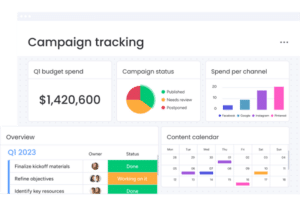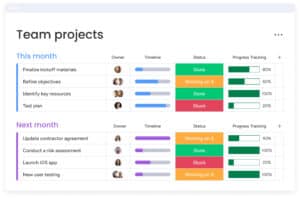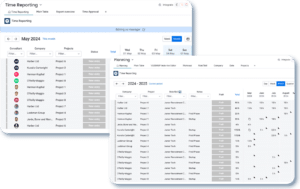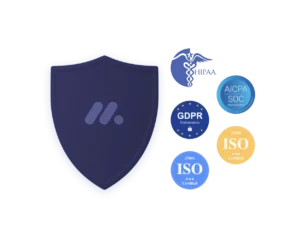Introduction
In the fast-paced world of project management, the ability to identify and eliminate productivity bottlenecks in project cycles is not just a skill—it’s a necessity for success. Whether you’re leading a small team or managing large-scale projects, understanding the intricacies of your project cycles can make a significant difference. This blog post delves deep into how to efficiently identify and eliminate productivity bottlenecks in project cycles, ensuring your projects not only meet but exceed expectations.
Productivity bottlenecks in project cycles are akin to roadblocks on a high-speed highway. They slow down progress, create frustration, and, if not managed properly, can lead to significant delays and cost overruns. The key to smooth and efficient project management lies in the ability to not only identify these bottlenecks swiftly but also to implement effective strategies to eliminate them. This process involves a keen understanding of your team’s dynamics, a thorough analysis of your workflow, and the application of targeted solutions to get your project cycle back on track.
Throughout this blog post, we will explore various strategies to identify and eliminate productivity bottlenecks in project cycles. From recognizing early signs of trouble to leveraging the latest tools and methodologies, we will provide you with actionable insights and practical tips. Our goal is to equip you with the knowledge and tools needed to ensure your projects run smoothly, efficiently, and free from unnecessary hold-ups.
Stay tuned as we dive into the world of project cycle efficiency, ensuring that the ability to identify and eliminate productivity bottlenecks becomes an integral part of your project management toolkit.
Recognizing the Signs of a Bottleneck
One of the first steps to effectively identify and eliminate productivity bottlenecks in project cycles is to recognize their signs. A bottleneck, much like a narrow passage in a bottle, restricts the flow. In project management, these bottlenecks can manifest in various ways, often subtly. By being vigilant and understanding these signs, you can take proactive measures to address them before they escalate.
Unusual Delays in Project Milestones
The most obvious sign of a bottleneck is when certain tasks or phases in your project consistently miss deadlines. These delays, especially if they recur at the same project stage, are clear indicators that something is impeding progress. Identifying these delays early is crucial in the process of eliminating productivity bottlenecks in project cycles. It enables project managers to dig deeper into the causes, whether they are related to resource allocation, task difficulty, or external factors.
Declining Team Morale and Increased Stress Levels
Often overlooked, the human element plays a critical role in identifying bottlenecks. A sudden drop in team morale or an increase in stress and frustration among team members can be a tell-tale sign of underlying issues. Bottlenecks often lead to work overload or feelings of stagnation, which, if not addressed, can snowball into bigger problems, hampering the ability to identify and eliminate productivity bottlenecks in project cycles effectively.
Resource Allocation Imbalances
Another key sign of a bottleneck is the imbalance in resource allocation. This can manifest as some team members being overburdened while others are underutilized. Such imbalances not only affect the project’s progress but also impact team dynamics and overall efficiency. Keeping an eye on resource distribution is essential in the ongoing effort to identify and eliminate productivity bottlenecks in project cycles.
Recognizing these signs is the first critical step in addressing the bottlenecks in your project cycles. With this knowledge, you can begin to delve into the root causes and take actionable steps to eliminate these obstacles, paving the way for more streamlined and efficient project management.
Omnitas Newsletter
Sign up for our monthly newsletter to stay up-to-date on our latest blog articles, videos and events!
Thank you!
You have successfully joined our subscriber list.
Analyzing Bottlenecks with the Right Tools
After identifying the signs of a bottleneck, the next step in the journey to identify and eliminate productivity bottlenecks in project cycles is to analyze them using the right tools. This analysis is crucial for understanding the root causes and determining the most effective strategies for resolution.
Leveraging Project Management Software
One of the most effective ways to analyze bottlenecks is through the use of sophisticated project management software like monday.com. These tools offer a comprehensive view of the project timeline, resource allocation, and individual task progress. By utilizing features such as Gantt charts, time tracking, and workload overviews, project managers can pinpoint where delays are occurring and why. This data-driven approach is integral to the process of identifying and eliminating productivity bottlenecks in project cycles, allowing for targeted interventions.
The Role of Data in Bottleneck Analysis
Data plays a pivotal role in understanding and resolving bottlenecks. Detailed analytics can reveal patterns and trends that might not be apparent at first glance. For instance, consistent delays in a particular phase might indicate a need for more resources or a revision of the approach in that area. By harnessing the power of data, teams can move beyond mere speculation and make informed decisions to identify and eliminate productivity bottlenecks in project cycles.
In this digital era, the ability to analyze project data efficiently is a game-changer in project management. With the right tools at your disposal, you can not only identify but also address the bottlenecks effectively, ensuring your projects stay on track and meet their objectives.
Strategic Approaches to Eliminating Bottlenecks
Identifying and analyzing bottlenecks are critical steps, but the true challenge lies in implementing strategies to effectively eliminate these bottlenecks. Here, we discuss various strategic approaches that can help you identify and eliminate productivity bottlenecks in project cycles, ensuring smoother operations and enhanced project success.
Streamlining Communication Channels
Effective communication is the backbone of any successful project. Bottlenecks often occur due to miscommunication or lack of information flow. Streamlining communication channels ensures that everyone is on the same page. This could involve regular team meetings, using collaborative tools, or setting up efficient reporting systems. A transparent and open communication framework is essential to quickly identify and eliminate productivity bottlenecks in project cycles.
Re-evaluating and Optimizing Processes
Sometimes, the root cause of a bottleneck is an outdated or inefficient process. It’s important to regularly re-evaluate and optimize these processes. This might involve automating repetitive tasks, reassigning roles to better suit team members’ strengths, or revising the project plan to be more realistic and achievable. Constant process improvement is crucial in the effort to identify and eliminate productivity bottlenecks in project cycles.
Emphasizing Agile Methodologies
Agile methodologies can be highly effective in dealing with bottlenecks. Agile’s iterative approach allows for more flexibility and quicker response times to challenges that arise during the project. By adopting agile principles, teams can better adapt to changes, address issues as they occur, and prevent the formation of significant bottlenecks. This adaptability is key to identify and eliminate productivity bottlenecks in project cycles.
By employing these strategic approaches, you can not only tackle existing bottlenecks but also put measures in place to prevent future issues. Remember, the goal is not just to complete the project but to do so efficiently and effectively, paving the way for continued success in all your future endeavours.

Implementing Changes and Maintaining Productivity
Successfully identifying and addressing productivity bottlenecks in project cycles is a significant achievement. However, the journey doesn’t end there. The next crucial phase is implementing the necessary changes and ensuring that these improvements are sustainable and continue to boost productivity in the long run.
Training and Development for Continuous Improvement
One of the most effective ways to maintain productivity post-bottleneck is to invest in training and development for your team. Educating team members about how to identify and eliminate productivity bottlenecks in project cycles is essential. This includes training on new tools, processes, and methodologies that were implemented to address the bottlenecks. Continuous learning and development not only empower your team but also foster a proactive culture that can anticipate and mitigate bottlenecks in the future.
Regular Review and Adaptation
The business environment is dynamic, and what works today may not be as effective tomorrow. Regular review of processes and strategies is crucial. This means consistently monitoring project progress, gathering feedback, and being open to adapting strategies as needed. This iterative approach ensures that your methods to identify and eliminate productivity bottlenecks in project cycles stay relevant and effective. Regular audits and retrospectives can be a part of this review process, ensuring ongoing improvement and adaptation.
Implementing these changes and maintaining a focus on continuous improvement is key to ensuring long-term productivity and success in your project cycles. By embedding these practices into your organization’s culture, you can create a resilient and efficient workflow, capable of adapting to new challenges and opportunities as they arise.
Conclusion
Throughout this exploration of how to identify and eliminate productivity bottlenecks in project cycles, we’ve covered a range of strategies and insights. From recognizing the early signs of bottlenecks to analyzing them with the right tools, from implementing strategic solutions to ensuring sustainable productivity, the journey is comprehensive and ongoing.
The key takeaway is that the ability to identify and eliminate productivity bottlenecks in project cycles is not a one-time task but an integral part of continuous project management improvement. It requires vigilance, adaptability, and a commitment to continuous learning and development. By applying the strategies discussed, you can enhance the efficiency of your projects, leading to more successful outcomes and a more engaged team.
Remember, every project is an opportunity to refine your processes, learn from previous challenges, and apply new strategies. The path to eliminating productivity bottlenecks is paved with innovation, collaboration, and an unwavering focus on improvement.
As we conclude, we invite you to reflect on these strategies and consider how they can be implemented in your own project cycles. And for those looking for expert guidance and tools to aid in this journey, Omnitas is here to help. Our expertise in project management solutions, coupled with powerful tools like monday.com, can transform your project cycles and help you achieve new heights of productivity and success.
Ready to take your project management to the next level? Book a free consultation with us below to explore how we can help you identify and eliminate productivity bottlenecks in your project cycles, ensuring smoother, more efficient, and successful project outcomes.
If you found this blog post useful, make sure to sign up for our monthly newsletter below. Stay in the loop regarding all things business efficiency!
























